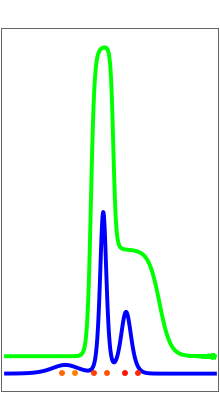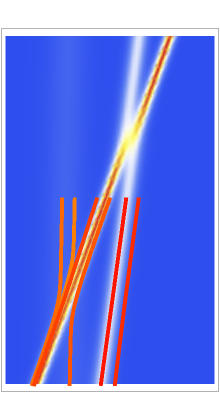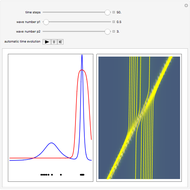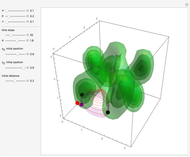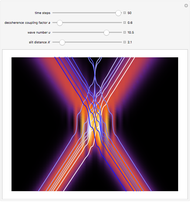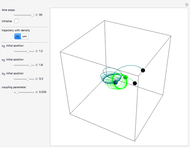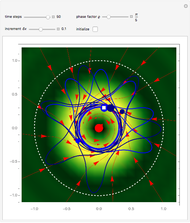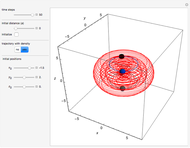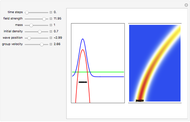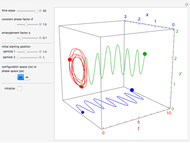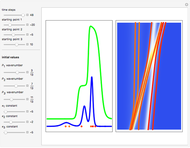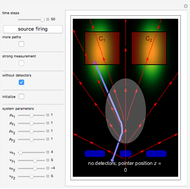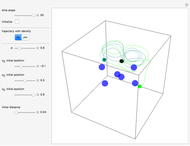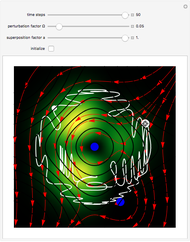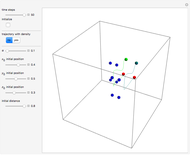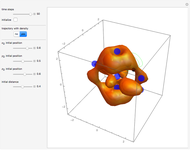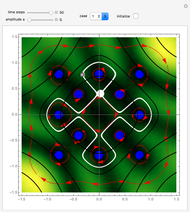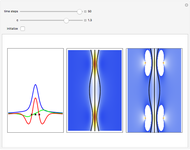Three-Soliton Collision in the Trajectory Approach

Requires a Wolfram Notebook System
Interact on desktop, mobile and cloud with the free Wolfram Player or other Wolfram Language products.
This Demonstration determines the streamlines or trajectories of idealized particles in a three-soliton collision, according to the Korteweg–de Vries equation (KdV) in  space. The collision of three solitons with different amplitudes involves the wave numbers
space. The collision of three solitons with different amplitudes involves the wave numbers  ,
,  , and
, and  . These are, in turn, determined by the dispersion relations, given the speed of each wave. For the three-soliton system, the wave velocity depends on the amplitude. The constants
. These are, in turn, determined by the dispersion relations, given the speed of each wave. For the three-soliton system, the wave velocity depends on the amplitude. The constants  ,
,  , and
, and  determine the initial positions of the peaks of each soliton. The streamlines of the particles follow the current flow, which can be derived from the continuity equation. The concept of a trajectory is based on the causal interpretation of quantum mechanics developed by David Bohm. The three-soliton result is obtained by the Hirota direct method. The graphic on the left shows the density (blue) and the velocity (green) of the idealized particles. On the right, you can see the density and the trajectories in
determine the initial positions of the peaks of each soliton. The streamlines of the particles follow the current flow, which can be derived from the continuity equation. The concept of a trajectory is based on the causal interpretation of quantum mechanics developed by David Bohm. The three-soliton result is obtained by the Hirota direct method. The graphic on the left shows the density (blue) and the velocity (green) of the idealized particles. On the right, you can see the density and the trajectories in  space.
space.
Contributed by: Klaus von Bloh (January 2016)
Open content licensed under CC BY-NC-SA
Snapshots
Details
In 1971 Hirota introduced a new direct method for constructing multi-soliton solutions to the integrable nonlinear Korteweg–de Vries equation  with the partial derivative
with the partial derivative  and so on. The Hirota direct method makes a transformation to a bilinear equation via the transformation
and so on. The Hirota direct method makes a transformation to a bilinear equation via the transformation  so that in the new form, the multi-soliton solutions can be solved using the Hirota
so that in the new form, the multi-soliton solutions can be solved using the Hirota  -operator.
-operator.
Specifically, the bilinear equation for the Korteweg–de Vries equation is
 ,
,
which can be solved by the Hirota  -operator
-operator
 .
.
In the original work of Hirota, the KdV equation is solved using the ansatz
 ,
,
where the  matrix
matrix  has the form
has the form
 ,
,
where  is the Kronecker delta and
is the Kronecker delta and  with the constant phase factor
with the constant phase factor  .
.
In practice, for the three-soliton, the  matrix
matrix  is given by
is given by
 ,
,
where
 ,
,  ,
,  ,
,
 ,
,  , and
, and  .
.
The motion of the particles associated with the current flow can be extracted from the continuity equation  . The guiding equations depend only on the velocity, which for the KdV equation become
. The guiding equations depend only on the velocity, which for the KdV equation become  .
.
With the transformation  the velocity term, which is also bilinear, is
the velocity term, which is also bilinear, is
 .
.
The starting points of possible trajectories inside the wave can be chosen by the settings  ,
,  , and
, and  . The initial points should be distributed around the peak of each wave. The single trajectories are calculated using
. The initial points should be distributed around the peak of each wave. The single trajectories are calculated using  . The system is time reversible:
. The system is time reversible:  . Due to the singularities, the size of the velocity term, and computational limitations, the wave numbers
. Due to the singularities, the size of the velocity term, and computational limitations, the wave numbers  have to be chosen carefully.
have to be chosen carefully.
References
[1] R. Hirota, "Exact Solution of the Korteweg–de Vries Equation for Multiple Collisions of Solitons," Physical Review Letters, 27(18), 1971 pp. 1192–1194. doi:10.1103/PhysRevLett.27.1192.
[2] "Bohmian-Mechanics.net." (Jan 6, 2015) www.bohmian-mechanics.net/index.html.
[3] S. Goldstein. "Bohmian Mechanics." The Stanford Encyclopedia of Philosophy. (Mar 4, 2013)plato.stanford.edu/entries/qm-bohm.
Permanent Citation
